程序员面试题精选100题
算法面试经典100题
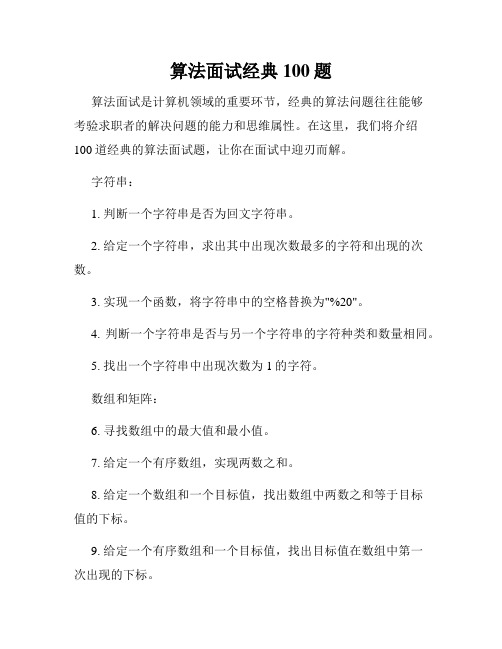
算法面试经典100题算法面试是计算机领域的重要环节,经典的算法问题往往能够考验求职者的解决问题的能力和思维属性。
在这里,我们将介绍100道经典的算法面试题,让你在面试中迎刃而解。
字符串:1. 判断一个字符串是否为回文字符串。
2. 给定一个字符串,求出其中出现次数最多的字符和出现的次数。
3. 实现一个函数,将字符串中的空格替换为"%20"。
4. 判断一个字符串是否与另一个字符串的字符种类和数量相同。
5. 找出一个字符串中出现次数为1的字符。
数组和矩阵:6. 寻找数组中的最大值和最小值。
7. 给定一个有序数组,实现两数之和。
8. 给定一个数组和一个目标值,找出数组中两数之和等于目标值的下标。
9. 给定一个有序数组和一个目标值,找出目标值在数组中第一次出现的下标。
10. 给定一个二维矩阵和一个目标值,找出目标值在矩阵中的位置。
链表:11. 反转链表。
12. 删除链表中的重复节点。
13. 找到链表的中间节点。
14. 找到链表的倒数第k个节点。
15. 判断链表是否为回文链表。
树:16. 实现二叉查找树,并对其进行插入和查找操作。
17. 实现二叉查找树的前序、中序和后序遍历。
18. 实现二叉查找树的广度优先遍历。
19. 判断两棵二叉树是否相同。
20. 判断一棵二叉树是否为平衡二叉树。
图:21. 判断一张图是否为二分图。
22. 实现拓扑排序。
23. 实现最短路径算法(如Dijkstra算法)。
24. 实现最小生成树算法(如Prim算法和Kruskal算法)。
25. 实现图的遍历(如深度优先遍历和广度优先遍历)。
排序和查找:26. 实现冒泡排序。
27. 实现快速排序。
28. 实现选择排序。
29. 实现插入排序。
30. 实现归并排序。
31. 实现希尔排序。
32. 实现堆排序。
33. 实现计数排序。
34. 实现基数排序。
35. 实现查找算法(如二分查找和哈希查找)。
动态规划:36. 实现斐波那契数列。
软件工程师岗位面试题及答案(经典版)

软件工程师岗位面试题及答案1.请介绍一次您在团队中解决复杂技术问题的经历。
答案:在上一家公司,我们遇到了一个性能瓶颈问题,导致应用程序响应变慢。
通过分析代码,我发现了数据库查询优化的机会。
我重新设计了查询,减少了查询时间,从而提升了应用程序的性能。
2.请谈谈您在版本控制系统中的经验,以及您如何处理合并冲突。
答案:我熟悉Git,并且经常使用分支进行开发。
当出现合并冲突时,我会首先理解冲突的本质,然后与团队成员讨论解决方案。
我们会在测试环境中验证修改,确保没有引入新问题。
3.在敏捷开发中,您如何确保团队按时交付功能?答案:我在敏捷开发团队中担任过ScrumMaster角色。
我会协助制定冲刺目标,跟踪任务的进度,及时解决障碍,并确保团队保持高效沟通,以确保按时交付。
4.您如何保证代码质量和可维护性?答案:我重视代码审查和单元测试。
代码审查可以发现潜在问题并提供改进建议,而单元测试可以确保代码的正确性。
我还注重编写清晰的文档,以便将来维护和扩展代码。
5.请描述一个您在项目中使用设计模式解决问题的实例。
答案:在一个电子商务项目中,我们需要实现不同支付方式的接口,以支持多种支付方式。
我采用了策略模式,将每种支付方式封装为一个独立的类,并在运行时动态选择合适的支付策略。
6.如何处理一个需求变更,该变更可能对项目进度产生影响?答案:首先,我会与产品经理和团队讨论变更的紧急性和影响。
如果变更必要且合理,我们将评估其对进度的影响,并相应地进行调整,可能会重新分配资源或者调整冲刺计划。
7.您在持续集成和持续交付方面有何经验?答案:我在多个项目中使用Jenkins进行持续集成和交付。
我设置了自动化构建和测试流程,并确保每次提交都会触发构建和测试,从而及早发现问题并快速修复。
8.请说明您在保障应用程序安全性方面的做法。
答案:我会定期进行安全漏洞扫描和代码审查,确保代码没有潜在的安全隐患。
我还会采用输入验证、身份认证和授权等措施来保护应用程序免受攻击。
软件开发工程师面试题及答案

软件开发工程师面试题及答案在软件开发领域,面试是选拔优秀人才的关键环节。
以下是一些常见的软件开发工程师面试题及相应的答案参考。
一、基础知识类1、什么是面向对象编程(OOP)?它的主要特点有哪些?答:面向对象编程是一种编程范式,它将数据和对数据的操作封装在对象中。
主要特点包括封装、继承和多态。
封装是将数据和方法包装在一个类中,隐藏内部实现细节;继承允许一个类从另一个类继承属性和方法,实现代码复用;多态则是同一个方法在不同的对象中有不同的实现方式。
2、解释一下进程和线程的区别。
答:进程是程序的一次执行过程,拥有独立的内存空间;线程是进程中的一个执行单元,多个线程共享进程的内存空间。
进程的创建和销毁开销较大,而线程相对较小。
进程间通信相对复杂,线程间通信较为简单。
3、谈谈你对数据库索引的理解。
答:数据库索引是一种用于提高数据库查询效率的数据结构。
它就像是一本书的目录,可以快速定位到所需的数据。
常见的索引类型有B 树索引、哈希索引等。
索引可以加快查询速度,但过多或不恰当的索引会导致数据插入、更新和删除的性能下降。
二、编程语言类1、如果让你用 Python 实现一个冒泡排序算法,你会怎么做?答:```pythondef bubble_sort(arr):n = len(arr)for i in range(n):for j in range(0, n i 1):if arrj > arrj + 1 :arrj, arrj + 1 = arrj + 1, arrj```2、在 Java 中,如何实现线程同步?答:在Java 中,可以使用`synchronized` 关键字来实现线程同步。
可以将方法声明为`synchronized` ,或者使用同步块。
另外,还可以使用`Lock` 接口和相关实现类来实现更灵活的线程同步。
3、谈谈 C++中的指针和引用的区别。
答:指针是一个变量,存储的是另一个变量的内存地址;引用则是一个别名,必须在初始化时绑定到一个对象,并且之后不能再重新绑定。
面试题目100及最佳答案
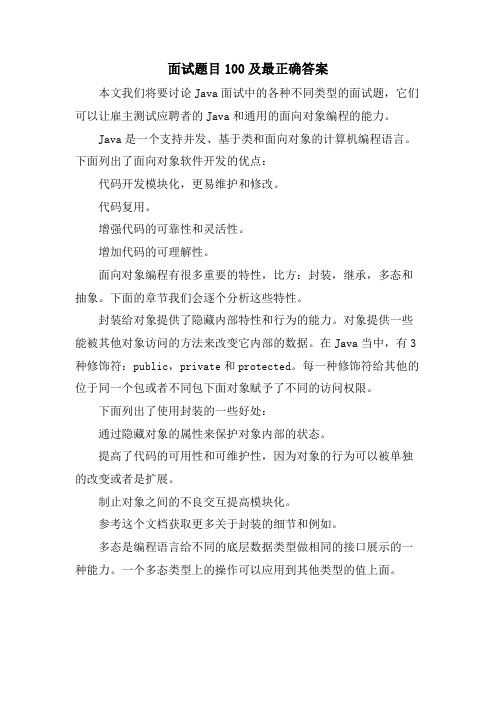
面试题目100及最正确答案本文我们将要讨论Java面试中的各种不同类型的面试题,它们可以让雇主测试应聘者的Java和通用的面向对象编程的能力。
Java是一个支持并发、基于类和面向对象的计算机编程语言。
下面列出了面向对象软件开发的优点:代码开发模块化,更易维护和修改。
代码复用。
增强代码的可靠性和灵活性。
增加代码的可理解性。
面向对象编程有很多重要的特性,比方:封装,继承,多态和抽象。
下面的章节我们会逐个分析这些特性。
封装给对象提供了隐藏内部特性和行为的能力。
对象提供一些能被其他对象访问的方法来改变它内部的数据。
在Java当中,有3种修饰符:public,private和protected。
每一种修饰符给其他的位于同一个包或者不同包下面对象赋予了不同的访问权限。
下面列出了使用封装的一些好处:通过隐藏对象的属性来保护对象内部的状态。
提高了代码的可用性和可维护性,因为对象的行为可以被单独的改变或者是扩展。
制止对象之间的不良交互提高模块化。
参考这个文档获取更多关于封装的细节和例如。
多态是编程语言给不同的底层数据类型做相同的接口展示的一种能力。
一个多态类型上的操作可以应用到其他类型的值上面。
继承给对象提供了从基类获取字段和方法的能力。
继承提供了代码的重用行,也可以在不修改类的情况下给现存的类添加新特性。
抽象是把想法从详细的实例中别离出来的步骤,因此,要根据他们的功能而不是实现细节来创立类。
Java支持创立只暴漏接口而不包含方法实现的抽象的类。
这种抽象技术的主要目的是把类的行为和实现细节别离开。
抽象和封装是互补的概念。
一方面,抽象关注对象的行为。
另一方面,封装关注对象行为的细节。
一般是通过隐藏对象内部状态信息做到封装,因此,封装可以看成是用来提供抽象的一种策略。
1.什么是Java虚拟机?为什么Java被称作是“平台无关的编程语言”?Java虚拟机是一个可以执行Java字节码的虚拟机进程。
Java 源文件被编译成能被Java虚拟机执行的字节码文件。
c语言面试题目100及最佳答案

c语言面试题目100及最佳答案作为IT行业人士需要掌握的最基本的计算机语言—c语言,如今的地位只高不低,c语言掌握程度的高低往往在面试的时候可以完全表现出来,而有些问题是大家平时似乎是知道的,但却不能完整准确地回答上来的,今天大家带来精心整理的C语言经典面试题,希望对大家有所帮助.1、请填写bool , float, 指针变量与“零值”比较的if语句。
提示:这里“零值”可以是0, 0。
0 , FALSE 或者“空指针”。
例如int 变量n 与“零值”比较的if 语句为:if ( n == 0 )if ( n != 0 )以此类推。
(1)请写出bool flag 与“零值”比较的if 语句:【标准答案】if ( flag ) if ( !flag )100 条经典 C语言笔试题目(2)请写出float x 与“零值"比较的if 语句:【标准答案】 const float EPSINON = 0.00001;if ((x 〉= - EPSINON) &&(x <= EPSINON)不可将浮点变量用“==" 或“!=" 与数字比较,应该设法转化成“〉=”或“〈=”此类形式。
100 条经典 C语言笔试题目(3)请写出char *p 与“零值"比较的if 语句【标准答案】 if (p == NULL) if (p != NULL)2、以下为Linux下的32 位C 程序,请计算sizeof 的值。
char str[] = “Hello”;char *p = str ;i nt n = 10;请计算(1)sizeof (str ) = (2)s i zeof ( p ) = (3)sizeof ( n ) =【标准答案】(1)6、(2)4 、(3 )4(4)void Func ( char str[100]){……;}请计算sizeof( str ) =(5)void * p = mall oc( 100 );请计算sizeof ( p ) =【标准答案】(4)4、(5)44、用变量a 给出下面的定义e) 一个有10个指针的数组,该指针是指向一个整型数的;f) 一个指向有10个整型数数组的指针;g)一个指向函数的指针,该函数有一个整型参数并返回一个整型数;h) 一个有10个指针的数组,该指针指向一个函数,该函数有一个整型参数并返回一个整型数;【标准答案】e)int * a[10]; f)int (*a)[10]g)int (*a)(int); h) int (*a[10])(int)5、设有以下说明和定义:typedef u nion {long i; int k[5]; char c;} DATE;struct data { int cat; DATE cow; double dog;} too; DATE max;则语句printf("%d",sizeof(struct date)+sizeof(max));的执行结果是:_____【标准答案】DATE是一个union,变量公用空间。
程序员面试题精选100题

程序员面试题精选100题1. 什么是面向对象编程(OOP)?列举几种常见的面向对象编程语言。
2. 解释一下封装、继承和多态的概念。
3. 什么是数据结构?列举几种常见的数据结构。
4. 解释一下栈和队列的概念,并提供它们的实际应用场景。
5. 什么是算法?解释一下时间复杂度和空间复杂度的概念。
6. 解释一下HTTP协议的工作原理。
7. 什么是数据库事务?解释一下ACID原则。
8. 解释一下前端开发中的MVC和MVVM模式。
9. 解释一下正向代理和反向代理的区别。
10. 什么是RESTful API?列举一些常见的HTTP请求方法。
11. 解释一下同步和异步的概念,以及它们的区别。
12. 解释一下进程和线程的概念,并提供它们的区别。
13. 解释一下操作系统中的死锁问题,以及如何避免死锁。
14. 解释一下TCP/IP协议族的组成部分。
15. 什么是单元测试?解释一下TDD(测试驱动开发)的概念。
16. 解释一下版本控制系统中的分布式版本控制和集中式版本控制的区别。
17. 什么是软件设计模式?列举几种常见的软件设计模式。
18. 解释一下Web应用程序中的会话管理机制,以及如何处理会话跟踪。
19. 解释一下缓存的工作原理,并提供一些常见的缓存算法。
20. 什么是虚拟机?解释一下虚拟化技术的概念。
21. 解释一下操作系统中的文件系统,以及不同类型的文件系统。
22. 解释一下数据库索引的概念,以及为什么使用索引可以提高查询性能。
23. 什么是反射?解释一下反射在Java中的应用。
24. 解释一下关系型数据库和非关系型数据库的区别。
25. 什么是分布式系统?列举一些常见的分布式系统架构。
26. 解释一下HTTP和HTTPS的区别,以及为什么使用HTTPS更安全。
27. 解释一下云计算的概念,以及云计算的优势和劣势。
28. 什么是容器化?解释一下Docker的工作原理。
29. 解释一下RESTful风格的API设计原则。
软件工程师常见面试题

软件工程师常见面试题在当今竞争激烈的就业市场中,软件工程师的岗位备受青睐。
而面试则是通往这一岗位的关键环节,面试官通常会通过一系列问题来评估候选人的技术能力、解决问题的能力、团队协作能力以及沟通能力等。
以下是一些常见的软件工程师面试题:一、技术基础类1、谈谈你对面向对象编程(OOP)的理解,以及其三大特性(封装、继承、多态)在实际开发中的应用。
面向对象编程是一种编程范式,它将数据和操作数据的方法封装在一起,形成对象。
封装可以隐藏对象的内部实现细节,只暴露必要的接口,提高了代码的安全性和可维护性。
继承允许子类继承父类的属性和方法,实现代码的复用和扩展。
多态则使得同一个方法在不同的对象上有不同的实现方式,增强了程序的灵活性和可扩展性。
比如,在一个图形绘制的程序中,可以定义一个父类“Shape”,然后派生出子类“Circle”、“Rectangle”等,通过多态,可以用统一的接口来绘制不同的图形。
2、解释一下什么是数据库索引,以及它的作用和可能带来的弊端。
数据库索引是一种数据库结构,用于加快数据的查询和检索速度。
它就像一本书的目录,通过索引可以快速定位到所需的数据,而不必全表扫描。
索引的作用显著,能够大大提高查询效率,特别是在处理大型数据表时。
然而,索引也并非完美无缺。
创建和维护索引需要消耗系统资源,过多的索引会增加数据插入、更新和删除的开销。
此外,对于很少用于查询或者数据量较小的表,创建索引可能得不偿失。
3、请简述一下常见的排序算法(如冒泡排序、快速排序、归并排序等)的时间复杂度和空间复杂度,并比较它们的优缺点。
冒泡排序的时间复杂度为 O(n²),空间复杂度为 O(1)。
它的优点是实现简单,易于理解,缺点是效率较低。
快速排序的平均时间复杂度为 O(nlogn),最坏情况为 O(n²),空间复杂度为 O(logn)到 O(n)。
它在大多数情况下效率很高,但在最坏情况下性能不佳。
归并排序的时间复杂度为 O(nlogn),空间复杂度为 O(n)。
高级程序员面试题及答案(完整版)
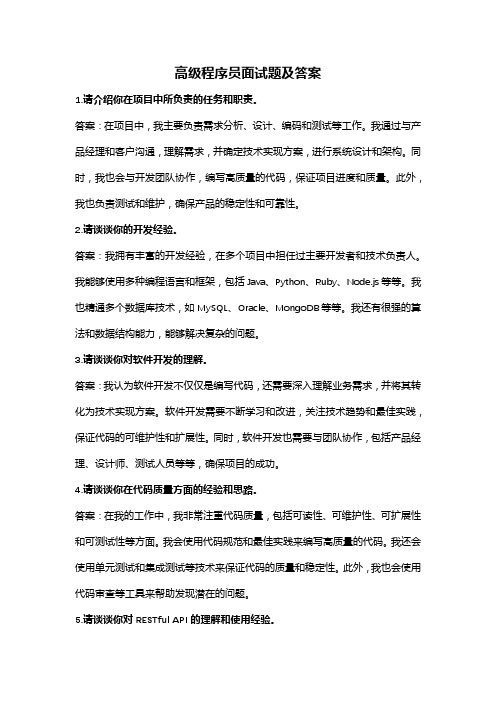
高级程序员面试题及答案1.请介绍你在项目中所负责的任务和职责。
答案:在项目中,我主要负责需求分析、设计、编码和测试等工作。
我通过与产品经理和客户沟通,理解需求,并确定技术实现方案,进行系统设计和架构。
同时,我也会与开发团队协作,编写高质量的代码,保证项目进度和质量。
此外,我也负责测试和维护,确保产品的稳定性和可靠性。
2.请谈谈你的开发经验。
答案:我拥有丰富的开发经验,在多个项目中担任过主要开发者和技术负责人。
我能够使用多种编程语言和框架,包括Java、Python、Ruby、Node.js等等。
我也精通多个数据库技术,如MySQL、Oracle、MongoDB等等。
我还有很强的算法和数据结构能力,能够解决复杂的问题。
3.请谈谈你对软件开发的理解。
答案:我认为软件开发不仅仅是编写代码,还需要深入理解业务需求,并将其转化为技术实现方案。
软件开发需要不断学习和改进,关注技术趋势和最佳实践,保证代码的可维护性和扩展性。
同时,软件开发也需要与团队协作,包括产品经理、设计师、测试人员等等,确保项目的成功。
4.请谈谈你在代码质量方面的经验和思路。
答案:在我的工作中,我非常注重代码质量,包括可读性、可维护性、可扩展性和可测试性等方面。
我会使用代码规范和最佳实践来编写高质量的代码。
我还会使用单元测试和集成测试等技术来保证代码的质量和稳定性。
此外,我也会使用代码审查等工具来帮助发现潜在的问题。
5.请谈谈你对RESTful API的理解和使用经验。
答案:我对RESTful API有着深刻的理解和使用经验。
RESTful API是一种基于HTTP协议的API设计风格,它强调资源的URI和HTTP动词的使用。
我会遵循RESTful API的设计原则,使用标准的HTTP动词(GET、POST、PUT、DELETE等),并使用恰当的HTTP状态码和响应格式。
我也会使用Swagger等工具来生成API 文档和进行测试。
6.请谈谈你在数据库方面的经验和能力。
软件工程师面试题(含答案)

软件工程师面试题(含答案)软件工程师面试题(含答案)作为软件工程师,面试是进入理想职位的一道门槛。
面试官常常通过技术问题来评估面试者的实际能力和知识水平。
在本文中,我们将介绍一些常见的软件工程师面试题,并给出详细的答案和解析。
一、数据结构与算法1. 请解释什么是数据结构?它在软件开发中的作用是什么?数据结构是一种组织和存储数据的方式,它决定了数据元素之间的关系。
在软件开发中,数据结构的选择可以直接影响程序的性能和效率。
合理选择和使用数据结构可以提高程序的执行效率,提高内存利用率,并降低算法的时间复杂度。
2. 请解释栈(Stack)和队列(Queue)的概念,并比较它们的差异。
栈是一种遵循先进后出(LIFO)原则的数据结构,只允许在栈顶进行插入和删除操作。
队列是一种遵循先进先出(FIFO)原则的数据结构,允许在队尾插入元素,在对头删除元素。
栈和队列的主要差异在于插入和删除操作的位置不同。
3. 请解释常见的排序算法,如冒泡排序、选择排序和快速排序,并比较它们的效率。
冒泡排序是一种简单的排序算法,它重复地比较相邻的两个元素,如果它们的顺序错误,则交换它们的位置。
选择排序是一种简单的排序算法,它每次选择最小的元素放到已排序序列的末尾。
快速排序是一种常用的分治法排序算法,它通过选择一个基准元素,将数据分为左右两个子序列进行递归排序。
相比于冒泡排序和选择排序,快速排序通常具有更高的效率。
二、编程语言与开发工具1. 请解释面向对象编程(OOP)的概念,并列举几种面向对象编程语言。
面向对象编程是一种编程思想,它将数据和操作数据的方法封装在一起,形成对象。
面向对象编程的核心概念包括封装、继承和多态。
常见的面向对象编程语言包括Java、C++、C#等。
2. 请解释什么是异常处理,为什么在开发过程中需要使用异常处理机制?异常处理是一种用于处理程序错误和异常情况的机制。
在开发过程中,不可避免会出现各种意外情况,如文件不存在、网络连接断开等。
中科软java程序员笔试题面试题
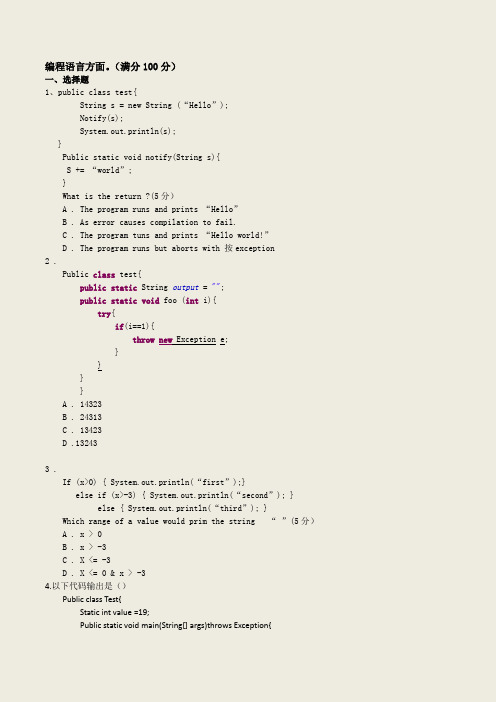
编程语言方面。
(满分100分)一、选择题1、public class test{String s = new String (“Hello”);Notify(s);System.out.println(s);}Public static void notify(String s){S += “world”;}What is the return ?(5分)A . The program runs and prints “Hello”B . As error causes compilation to fail.C . The program tuns and prints “Hello world!”D . The program runs but aborts with 按exception2 .Public class test{public static String output = "";public static void foo (int i){try{if(i==1){throw new Exception e;}}}}A . 14323B . 24313C . 13423D .132433 .If (x>0) { System.out.println(“first”);}else if (x>-3) { System.out.println(“second”); }else { System.out.println(“third”); }Which range of a value would prim the string “”(5分)A . x > 0B . x > -3C . X <= -3D . X <= 0 & x > -34.以下代码输出是()Public class Test{Static int value =19;Public static void main(String[] args)throws Exception{Test().printValue();}Private void printValue(){int value =69;System.out.println(this.value);}}二、简答1、说明MVC各层的作用,请尽量列举各层所采用的技术或者框架2、什么情况下会使用java序列化,如何实现java序列化?3、哪些框架或技术里用到了拦截器或者过滤器,其作用是什么?4、AJAX中的XMLHttpRequest对象在IE和Firefox中分别如何创建5、jquery的选择器有哪几种?请简单说明其含义6.列举JSP中的内置对象,7.JSP如何获取HTML FORM 中的数据?(15分)8.介绍在jsp中如何使用JavaBean。
100道c++面试题(上)

100道c++⾯试题(上)1. new, delete, malloc, free关系new/delete是c++的运算符,delete会调⽤对象的析构函数;malloc/free是c/c++的标准库函数,free只释放内存。
2. delete和delete[]的区别delete只会调⽤⼀次析构函数,⽽delete[]会调⽤每⼀个成员的析构函数。
3. 对⽐c++和java4. 继承的优缺点5. c++有哪些性质(⾯向对象特点)封装、继承、多态6. ⼦类析构时要调⽤⽗类的析构函数吗?no7. 说说多态,虚函数,纯虚函数。
c++的多态具体体现在运⾏和编译两⽅⾯:在运⾏时的多态通过继承和虚函数来体现;编译时的多态体现在函数和运算符的重载。
抽象类不能⽤于直接创建对象实例,但仍可使⽤指向抽象类的指针⽀持运⾏时多态性。
(没理解qaq)8. 求返回值(微软)int func(x){int countx = 0;while(x){countx ++;x = x&(x-1);}return countx;}答案:8思路:将x转化成2进制,看含有1的个数。
9. 什么是“引⽤”?申明和使⽤“引⽤”要注意哪些问题?注意:引⽤不占存储单元。
不能建⽴数组的引⽤。
10. 将“引⽤”作为函数参数有哪些特点?11. 在什么时候需要使⽤“常引⽤”?既要利⽤引⽤提⾼程序的效率,⼜要保护传递给函数的数据不在函数中被改变。
const 类型标识符 &引⽤名=⽬标变量名注意:试图将const型对象转换为⾮const型是⾮法的;引⽤型参数应该在能被定义为const的情况下,尽量定义为const。
12. 将“引⽤”作为函数返回值类型的格式、好处和需要遵守的规则格式:类型标识符 &函数名 (形参列表及类型说明) {//函数体}好处:在内存中不产⽣被返回值的副本;注意:参考Effective C++(1)不能返回局部变量的引⽤。
程序员人事面试100题
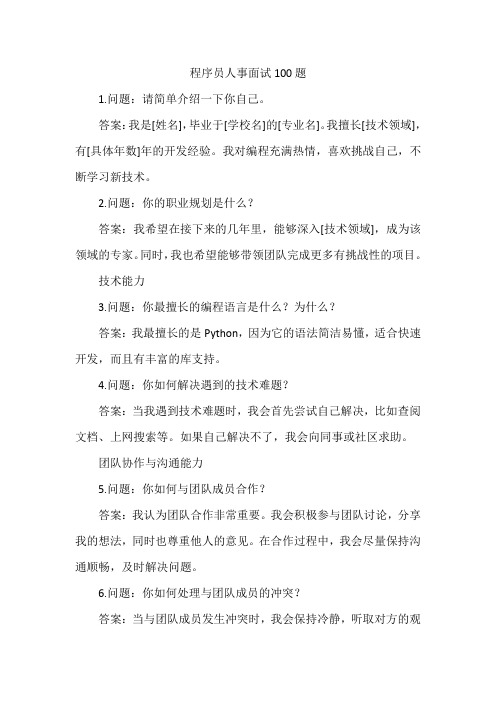
程序员人事面试100题1.问题:请简单介绍一下你自己。
答案:我是[姓名],毕业于[学校名]的[专业名]。
我擅长[技术领域],有[具体年数]年的开发经验。
我对编程充满热情,喜欢挑战自己,不断学习新技术。
2.问题:你的职业规划是什么?答案:我希望在接下来的几年里,能够深入[技术领域],成为该领域的专家。
同时,我也希望能够带领团队完成更多有挑战性的项目。
技术能力3.问题:你最擅长的编程语言是什么?为什么?答案:我最擅长的是Python,因为它的语法简洁易懂,适合快速开发,而且有丰富的库支持。
4.问题:你如何解决遇到的技术难题?答案:当我遇到技术难题时,我会首先尝试自己解决,比如查阅文档、上网搜索等。
如果自己解决不了,我会向同事或社区求助。
团队协作与沟通能力5.问题:你如何与团队成员合作?答案:我认为团队合作非常重要。
我会积极参与团队讨论,分享我的想法,同时也尊重他人的意见。
在合作过程中,我会尽量保持沟通顺畅,及时解决问题。
6.问题:你如何处理与团队成员的冲突?答案:当与团队成员发生冲突时,我会保持冷静,听取对方的观点。
如果是我的问题,我会承认并改正;如果是对方的问题,我会尝试以理服人。
如果双方无法达成一致,我会寻求上级或第三方的帮助。
问题解决与创新能力7.问题:你最近解决的一个技术问题是什么?答案:最近我解决了一个关于数据库性能的问题。
通过优化查询语句和索引,我成功提高了查询速度,减少了系统响应时间。
8.问题:你如何提高自己的创新能力?答案:我认为创新源于不断学习和实践。
我会关注新技术和新趋势,尝试将它们应用到实际工作中。
同时,我也会参加一些技术交流和分享活动,与同行交流思想,激发创新灵感。
9.问题:你如何进行自我提升?答案:我每年都会制定一个学习计划,列出需要掌握的新技术和知识领域。
通过参加在线课程、阅读技术书籍、观看教程视频等方式,不断提升自己的技能水平。
10.问题:你如何平衡工作与生活?答案:为了保持工作与生活的平衡,我会合理安排工作时间,避免加班。
100道C#面试题(.net开发人员必备)

100道C#面试题(.net开发人员必备)注明:经过本人面试的经历和在网上的资料整理出来的100道比较常见的C#面试题,想当初面试公司虽然不是很多,第一次找工作用了近两周的时间面试了二十多家公司,成功的不到十家,最后选择了一家大型的软件公司干了两个月就走人了。
后来又找了一周工作,面试了十一家公司,成功9家。
现在已经在公司工作了快两年的时间了。
以下的面试题也是自己曾经做过的,希望能帮助更多的同行找到满意的工作1. .NET和C#有什么区别答:.NET一般指 .NET FrameWork框架,它是一种平台,一种技术。
C#是一种编程语言,可以基于.NET平台的应用。
2.一列数的规则如下: 1、1、2、3、5、8、13、21、34...... 求第30位数是多少,用递归算法实现。
答:public class MainClass{public static void Main(){Console.WriteLine(Foo(30));}public static int Foo(int i){if (i <= 0)return 0;else if(i > 0 && i <= 2)return 1;else return Foo(i -1) + Foo(i - 2);}}3. C#中的委托是什么?事件是不是一种委托?答 : 委托可以把一个方法作为参数代入另一个方法。
委托可以理解为指向一个函数的引用。
是,是一种特殊的委托4. 简述 private、 protected、 public、internal 修饰符的访问权限。
答 . private : 私有成员, 在类的内部才可以访问。
protected: 保护成员,该类内部和继承类中可以访问。
public: 公共成员,完全公开,没有访问限制。
internal:在同一命名空间内可以访问。
5. override与重载的区别答:override 与重载的区别。
c_c++面试100题
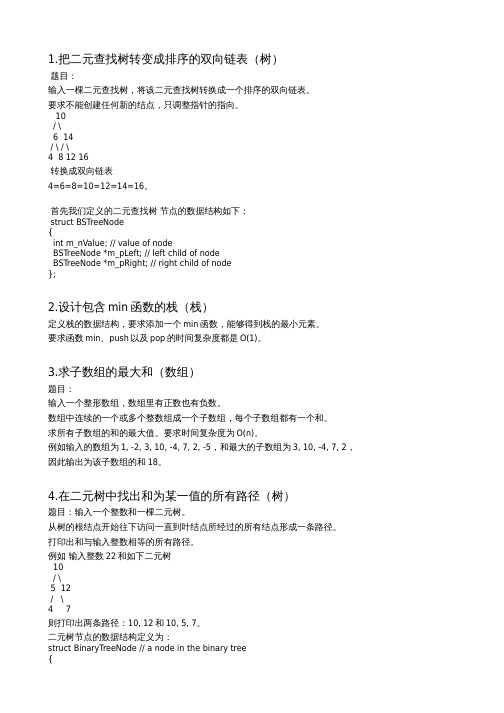
判断整数序列是不是二元查找树的后序遍历结果 题目:输入一个整数数组,判断该数组是不是某二元查找树的后序遍历的结果。 如果是返回 true,否则返回 false。 例如输入 5、7、6、9、11、10、8,由于这一整数序列是如下树的后序遍历结果:
8 /\ 6 10 /\ /\ 5 7 9 11 因此返回 true。 如果输入 7、4、6、5,没有哪棵树的后序遍历的结果是这个序列,因此返回 false。
第 15 题(树):
题目:输入一颗二元查找树,将该树转换为它的镜像, 即在转换后的二元查找树中,左子树的结点都大于右子树的结点。 用递归和循环两种方法完成树的镜像转换。 例如输入: 8 /\ 6 10 /\ /\ 5 7 9 11 输出:
8 /\ 10 6
/\ /\ 11 9 7 5 定义二元查找树的结点为: struct BSTreeNode // a node in the binary search tree (BST) { int m_nValue; // value of node BSTreeNode *m_pLeft; // left child of node BSTreeNode *m_pRight; // right child of node };
第 22 题(推理):
有 4 张红色的牌和 4 张蓝色的牌,主持人先拿任意两张,再分别在 A、B、C 三人额头上贴 任意两张牌, A、B、C 三人都可以看见其余两人额头上的牌,看完后让他们猜自己额头上是什么颜色的 牌, A 说不知道,B 说不知道,C 说不知道,然后 A 说知道了。 请教如何推理,A 是怎么知道的。 如果用程序,又怎么实现呢?
第 16 题(树):
题目(微软): 输入一颗二元树,从上往下按层打印树的每个结点,同一层中按照从左往右的顺序打印。 例如输入
计算机面试题目(3篇)

第1篇一、基础知识1. 请解释一下什么是位运算,并举例说明其应用场景。
位运算是指对二进制位进行操作的运算,主要包括按位与(&)、按位或(|)、按位异或(^)、按位取反(~)、左移(<<)和右移(>>)等。
以下是一些应用场景:(1)按位与:用于判断两个整数的某一位是否同时为1。
(2)按位或:用于将两个整数的对应位进行或运算,得到结果。
(3)按位异或:用于将两个整数的对应位进行异或运算,如果两个位相同,则结果为0;如果两个位不同,则结果为1。
(4)按位取反:用于将整数的每一位取反,即将0变为1,将1变为0。
(5)左移:用于将整数的二进制表示向左移动指定的位数,右边的位被丢弃,左边补0。
(6)右移:用于将整数的二进制表示向右移动指定的位数,左边的位被丢弃,右边补0。
2. 请解释一下什么是数据类型,并列举常见的几种数据类型。
数据类型是指用于定义变量存储的数据种类的类型。
以下是一些常见的几种数据类型:(1)整型(int):用于存储整数,如int a = 10;(2)浮点型(float、double):用于存储实数,如float b = 3.14;(3)字符型(char):用于存储单个字符,如char c = 'A';(4)布尔型(bool):用于存储布尔值,如bool d = true;(5)数组:用于存储一系列相同类型的数据,如int arr[10];(6)结构体(struct):用于存储不同类型的数据,如struct Person {int age; char name[20];};(7)指针:用于存储变量的地址,如int ptr = &a。
3. 请解释一下什么是面向对象编程,并举例说明其应用场景。
面向对象编程(OOP)是一种编程范式,它将数据和行为封装在对象中,强调继承、封装和多态。
以下是一些应用场景:(1)设计大型软件系统,如操作系统、数据库等;(2)开发图形用户界面(GUI)应用程序;(3)开发网络应用程序,如Web应用、移动应用等;(4)开发游戏和模拟软件。
- 1、下载文档前请自行甄别文档内容的完整性,平台不提供额外的编辑、内容补充、找答案等附加服务。
- 2、"仅部分预览"的文档,不可在线预览部分如存在完整性等问题,可反馈申请退款(可完整预览的文档不适用该条件!)。
- 3、如文档侵犯您的权益,请联系客服反馈,我们会尽快为您处理(人工客服工作时间:9:00-18:30)。
///////////////////////////////////////////////////////////////////// // // Covert a sub binary-search-tree into a sorted double-linked list // Input: pNode // // void ConvertNode(BSTreeNode* pNode, BSTreeNode*& pLastNodeInList) { if(pNode == NULL) return; BSTreeNode *pCurrent = pNode; the head of the sub tree pLastNodeInList - the tail of the double-linked list
if(asRight) { while(pTemp->m_pLeft) pTemp = pTemp->m_pLeft; } // If the current node is the left child of its parent, // return the greatest node in the tree whose root is the current node else { while(pTemp->m_pRight) pTemp = pTemp->m_pRight; } return pTemp; } ///////////////////////////////////////////////////////////////////// // // Covert a binary search tree into a sorted double-linked list // Input: the head of tree // Output: the head of sorted double-linked list ///////////////////////////////////////////////////////////////////// // BSTreeNode* Convert(BSTreeNode* pHeadOfTree) { // As we want to return the head of the sorted double-linked list, // we set the second parameter to be true return ConvertNode(pHeadOfTree, true); }
/blog/static/254111742007127104759245/
程序员 面试 题 精选 100 题 (01)-把二元查 找树 转 变 成排序的
双 向链 表
题目:输入一棵二元查找树,将该二元查找树转换成一个排序的双向链表。要求不能创建任何新的结点, 只调整指针的指向。 比如将二元查找树 10 / 6 / \ 4 转换成双向链表 4=6=8=10=12=14=16。 分析:本题是微软的面试题。很多与树相关的题目都是用递归的思路来解决,本题也不例外。 下面我们用两种不同的递归思路来分析。 思路一:当我们到达某一结点准备调整以该结点为根结点的子树时,先调整其左子树将左子树 转换成一个排好序的左子链表,再调整其右子树转换右子链表。最近链接左子链表的最右结点(左子树的 最大结点)、当前结点和右子链表的最左结点(右子树的最小结点)。从树的根结点开始递归调整所有结 点。 思路二:我们可以中序遍历整棵树。按照这个方式遍历树,比较小的结点先访问。如果我们每 访问一个结点,假设之前访问过的结点已经调整成一个排序双向链表,我们再把调整当前结点的指针将其 链接到链表的末尾。当所有结点都访问过之后,整棵树也就转换成一个排序双向链表了。 参考代码: 首先我们定义二元查找树结点的数据结构如下: / 8 12 \ 14 \ 16
程序员 面试 题 精选 100 题 (02)-设 计包含 min 函数 的栈
题目:定义栈的数据结构,要求添加一个 min 函数,能够得到栈的最小元素。要求函数 min、push 以及 pop 的时间复杂度都是 O(1)。 分析:这是去年 google 的一道面试题。 我看到这道题目时,第一反应就是每次 push 一个新元素时,将栈里所有逆序元素排序。这样栈顶元素将 是最小元素。但由于不能保证最后 push 进栈的元素最先出栈,这种思路设计的数据结构已经不是一个栈 了。 在栈里添加一个成员变量存放最小元素(或最小元素的位置)。每次 push 一个新元素进栈的时候,如果 该元素比当前的最小元素还要小,则更新最小元素。 乍一看这样思路挺好的。但仔细一想,该思路存在一个重要的问题:如果当前最小元素被 pop 出去,如何 才能得到下一个最小元素? 因此仅仅只添加一个成员变量存放最小元素(或最小元素的位置)是不够的。我们需要一个辅助栈。每次 push 一个新元素的时候,同时将最小元素(或最小元素的位置。考虑到栈元素的类型可能是复杂的数据结 构,用最小元素的位置将能减少空间消耗)push 到辅助栈中;每次 pop 一个元素出栈的时候,同时 pop 辅助栈。 参考代码:
思路一对应的代码:
///////////////////////////////////////////////////////////////////// // // Covert a sub binary-search-tree into a sorted double-linked list // Input: pNode - the head of the sub tree // // // BSTreeNode* ConvertNode(BSTreeNode* pNode, bool asRight) { if(!pNode) return NULL; BSTreeNode *pLeft = NULL; BSTreeNode *pRight = NULL; // Convert the left sub-tree if(pNode->m_pLeft) pLeft = ConvertNode(pNode->m_pLeft, false); // Connect the greatest node in the left sub-tree to the current node if(pLeft) { pLeft->m_pRight = pNode; pNode->m_pLeft = pLeft; } // Convert the right sub-tree if(pNode->m_pRight) pRight = ConvertNode(pNode->m_pRight, true); // Connect the least node in the right sub-tree to the current node if(pRight) { pNode->m_pRight = pRight; pRight->m_pLeft = pNode; } BSTreeNode *pTemp = pNode; // If the current node is the right child of its parent, // return the least node in the tree whose root is the current node asRight - whether pNode is the right child of its parent else return the greatest node in the sub-tree // Output: if asRight is true, return the least node in the sub-tree /////////////////////////////////////////////////////////////////////
#include <deque> #include <assert.h> template <typename T> class CStackWithMin { public: CStackWithMin(void) {} virtual ~CStackWithMin(void) {} T& top(void); const T& top(void) const; void push(const T& value); void pop(void); const T& min(void) const; private: T>m_data;// theelements of stack size_t>m_minIndex;// the indicesof minimum elements }; // get the last element of mutable stack
struct BSTreeNode // a node in the binary search tree { int m_nValue; // value of node BSTreeNode *m_pLeft; // left child of node BSTreeNode *m_pRight; // right child of node };
/////////////////////////////////////////////////////////////////////
// Convert the left sub-tree if (pCurrent->m_pLeft != NULL) ConvertNode(pCurrent->m_pLeft, pLastNodeInList); // Put the current node into the double-linked list pCurrent->m_pLeft = pLastNodeInList; if(pLastNodeInList != NULL) pLastNodeInList->m_pRight = pCurrent; pLastNodeInList = pCurrent; // Convert the right sub-tree if (pCurrent->m_pRight != NULL) ConvertNode(pCurrent->m_pRight, pLastNodeInList); } ///////////////////////////////////////////////////////////////////// // // Covert a binary search tree into a sorted double-linked list // Input: pHeadOfTree - the head of tree // Output: the head of sorted double-linked list ///////////////////////////////////////////////////////////////////// // BSTreeNode* Convert_Solution1(BSTreeNode* pHeadOfTree) { BSTreeNode *pLastNodeInList = NULL; ConvertNode(pHeadOfTree, pLastNodeInList); // Get the head of the double-linked list BSTreeNode *pHeadOfList = pLastNodeInList; while(pHeadOfList && pHeadOfList->m_pLeft) pHeadOfList = pHeadOfList->m_pLeft; return pHeadOfList; }
